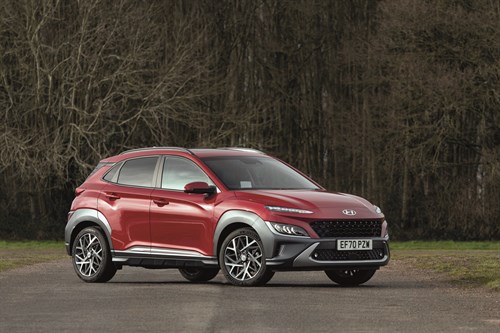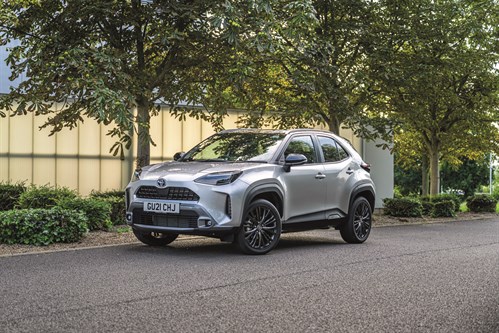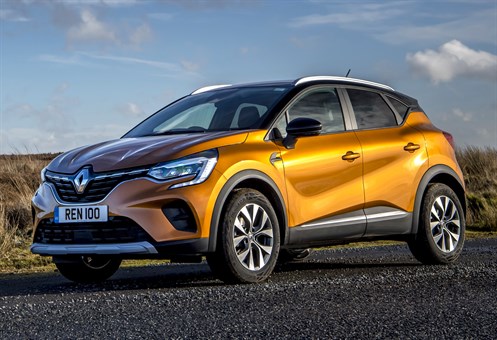We use cookies to ensure that we give you the best experience on our website. If you continue without changing your settings, we will assume that you are happy to receive all cookies on the Business Car website. However, if you would like to, you can change your cookies at any time

The start point for the best source of fleet information |
Best in Class: Small hybrid SUVs
Date: 02 September 2022 | Author: Martyn Collins

Nissan Juke
2022 almost seems like a restart for the Nissan brand. This year sees it launch this hybrid version of the Juke, plus e-Power hybrid versions of the bigger Qashqai and finally, the all-new Nissan Ariya crossover.
But back to the Juke Hybrid. You'll have to look hard to spot hybrid versions of the Juke on the outside, as the only giveaways are the new front grille design, with a smaller aperture to optimise aero efficiency, plus hybrid badging on the side and rear. If you choose the Tekna+ equipment grade, your Juke will be fitted with 19in Aero alloy wheels.
Inside the Juke Hybrid, a power gauge replaces the rev counter. The central TFT display can show how the Juke is being powered, whether it's by the engine or battery. There is a button in the centre console for the 'e-Pedal,' and another EV button in between the two central air vents, for an electric- only drive. The interior changes in the Juke Hybrid include a boot that has dropped 68 litres to 354 litres because of all the hybrid kit.
The clever stuff happens under the bonnet. Nissan claims the Juke showcases a true multi-modal powertrain, rather than enhancing the internal combustion engine with electric assistance. It works by pairing a 94hp, 1.6-litre petrol engine with a 36kW (49hp) electric motor, 15kW high voltage starter/generator, inverter and a 1.2kWh water-cooled battery. This is all held together with an advanced low friction multi-modal gearbox that provides optimal use of the propulsive power, whether electric, petrol engine, or both. To reduce friction, this gearbox uses dog clutches instead of conventional synchroniser rings to change the four gears for the ICE engine and a further two for the EV motor - all designed to work together to give what Nissan describe as a "smooth, connected, and responsive acceleration". In fact, the Juke's hybrid system is similar to the one fitted to the Renault Captur E-Tech, which is also included in this group.
BIK figure-wise, there's not much to choose between all four cars here, and on its own, the Nissan's 28% figure looks good. However, the similar Captur achieves a slightly better 26% figure, with the Kona just behind at 27%, but the real star is the Toyota Yaris Cross with its leading 25% BIK. The same goes for the emissions, with the Juke's 115g/km figure looking decent and the Hyundai just behind at 114g/km. But the leaders here are the 109g/km Renault and the winning Toyota with its 102g/km figure.
The Juke's hybrid powertrain equals a fuel consumption figure of 55.4mpg. This looks more impressive when the Kona can only just do a bit better at 56.5mpg and the Captur at 57.7mpg, but Toyota's knowledge from producing hybrid models for more than 20 years pays dividends with the Yaris Cross's winning 62.8mpg figure. Having spent time with a Yaris Cross, this figure seems entirely believable as we couldn't get the test car to go below 50mpg according to the instruments.
The first-generation Juke was key to the development of the B-SUV sector and both first and second-generation versions have been popular with fleet buyers, but sadly not enough to make it the residuals champ here. In fact, it finishes in last place, with its 39.87% figure, although this could have something to do with the fact that it's the most expensive model. The Kona might be showing its age, despite the recent facelift, as it comes next with its 40.10% figure. The Yaris Cross is still fairly new to the market and so far, has dazzled us here with its consumption. Despite Toyota's reputation for reliability and dependability, it's 40.94% can only put it in second place behind the winning Renault Captur with its 42.81% figure.
This is a close fight between the models we've chosen, and this can be best seen by the fact the Juke has only come top in one category, with the lowest SMR figure at £1,880. As such, the Juke finishes last, with its 51.04p overall cost-per-mile figure.
Nissan Juke 1.6h 143 N-Connecta
P11D: £27,015
CO2 (tax): 115g/km (28%)
BIK 20/40% a month: £120/£241
Fuel consumption: 55.4mpg
National Insurance: £3,415
First year VED: £180
Subsequent VED: £155
Engine size/power: 1,598cc/143hp
AFR: 17p
Residual value: 39.87%
Depreciation: £16,245
Fuel costs: £9,083
SMR: £1,880
Cost per mile: 51.04p

Hyundai Kona
Hyundai's Kona is one of the oldest cars in the group, with the original launched back in 2018. Since then, it has proved its one of the most durable in its class, spawning a full-EV version with 300-mile range, the hybrid we have here, and most recently, even a performance range-topper in the form of the'N.
Facelifted in 2021, the Kona received a new, wider front grille with larger lower air intake, slimmer headlights plus LED daytime running lights, and a restyled front bumper. Inside, there's a revised centre console and revised equipment grade, plus a new 10.25in digital instrument cluster and another 10.25in infotainment screen.
Under the bonnet, this Kona Hybrid is powered by a 1.6-litre, 104hp petrol with an added 1.56kWh battery and a 43hp electric motor. Because of the small battery you don't plug it in, but it still betters the Juke with its 56.5mpg fuel figure. The Kona's 27% BIK and fuel figure are only marginally better than the Juke, which is a long way behind the Toyota, but is close to the Renault Captur. However, in terms of cost per mile, it finishes just ahead of the Nissan, putting it in third place.
Hyundai Kona 1.6h-GDi Premium
P11D: £26,880
CO2 (tax): 114g/km (27%)
BIK 20/40% a month: £126/£252
Fuel consumption: 56.5mpg
National Insurance: £3,277
First year VED: £180
Subsequent VED: £155
Engine size/power: 1,580cc/139hp
AFR: 14p
Residual value: 40.10%
Depreciation: £16,100
Fuel costs: £8,906
SMR: £2,210
Cost per mile: 50.82p

Toyota Yaris Cross
Toyota was late to the small SUV party, but thanks to using the petrol hybrid technology that we've known since the original Prius, the Yaris Cross gives a strong performance here. This Toyota seems to fill the void for buyers where electrification doesn't work, and standard petrol engines are not frugal enough.
However, there's more to the Yaris Cross than just its frugality; it looks good, offers a tidy drive, the driving position is comfortable, and the dashboard design is uncluttered.
Design Tech is the mid-level equipment grade for the Yaris Cross, and has standard 8in "Toyota Touch" navigation, smartphone integration, plus Apple Carplay and Android Auto compatibility, 17in alloy wheels, and rear privacy glass. As mentioned before, this is one of the newest models in this group being launched in 2021, but Toyota's clever hybrid technology really gives it the edge here. It takes first place for BIK at 26%, finishes in first place for emissions with its 102g/km figure, and its 62.8mpg consumption also comes top. Yet, despite Toyota's excellent reputation for top residuals, its 40.94% and £15,290 depreciation figures are beaten by the Nissan Juke's sister car, the Renault Captur. Yet it's still enough for the Yaris Cross to take the win in the cost per mile stakes.
Toyota Yaris Cross 1.5VVT-h Design Tech
P11D: £26,325
CO2 (tax): 102g/km (25%)
BIK 20/40% a month: £109/£219
Fuel consumption: 62.8mpg
National Insurance: £2,932
First year VED: £190
Subsequent VED: £155
Engine size/power: 1,490cc/123hp
AFR: 17p
Residual value: 41.14%
Depreciation: £15,290
Fuel costs: £8,012
SMR: £1,952
Cost per mile: 46.98p
Renault Captur
The latest Captur has been on sale for over two years. Outside, you'll spot it by the curvier but still attractive styling. Apart from the distinctive looks, the current Captur has attracted the attention of fleet buyers with its impressive list of standard safety kit. Like its sister car, the Clio supermini, it too has a spacious, comfortable, and high quality interior.
Another positive of being based on the same platform as the Clio is that the Captur is available in hybrid (as we have here) and plug-in hybrid versions. That results in a 1.6-litre petrol engine with a 1.2kW battery, hidden just above the rear axle. This works out at a 109g/km CO2 figure and a 26% BiK implication - and it's still as good to drive.
The cheapest to buy of our group, the Captur has the second lowest BIK figure, yet the Renault betters the winning Yaris Cross with its 40.94% residual value, £14,975 depreciation and £26,180 P11D figures. The Captur therefore comes in at a commendable second place position in the cost per mile stakes, behind the winning Toyota.
Renault Captur 1.6 E-Tech 145 Techno
P11D: £26,180
CO2 (tax): 109g/km (26%)
BIK 20/40% a month: £113/£226
Fuel consumption: 57.7mpg
National Insurance: £3,073
First year VED: £160
Subsequent VED: £155
Engine size/power: 1,598cc/158hp
AFR: 17p
Residual value: 42.81%
Depreciation: £14,973
Fuel costs: £8,721
SMR: £2,052
Cost per mile: 48.03p












